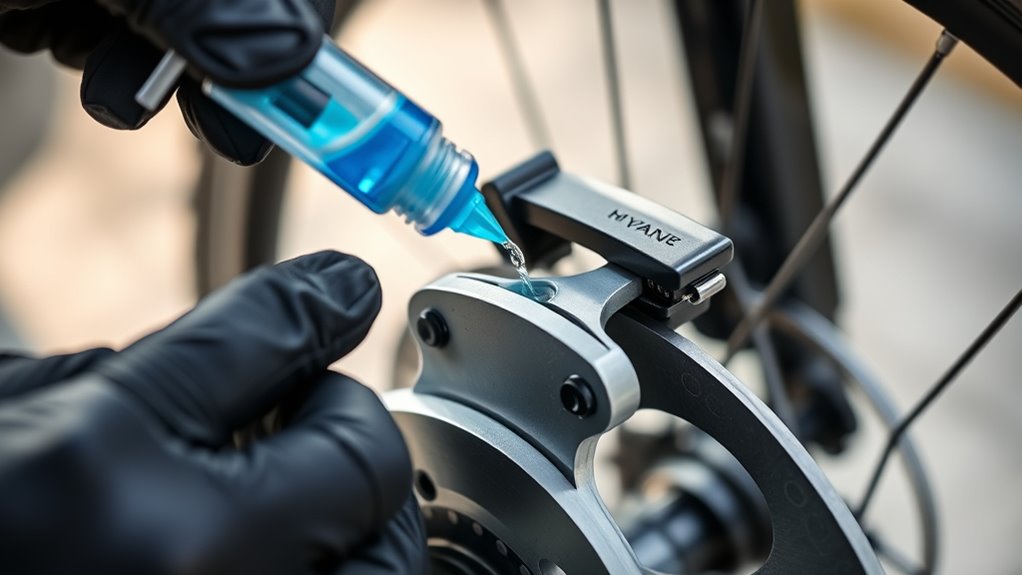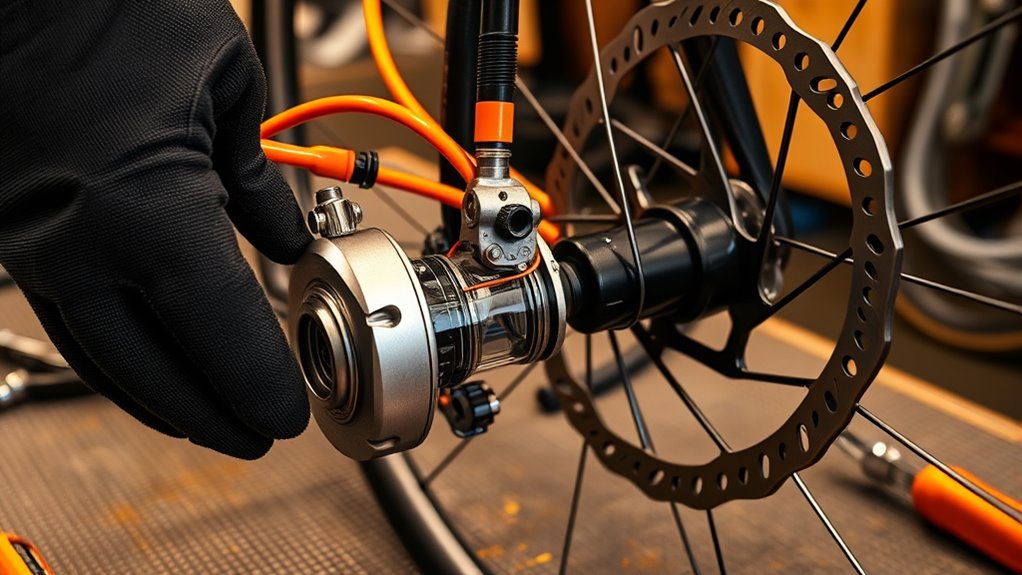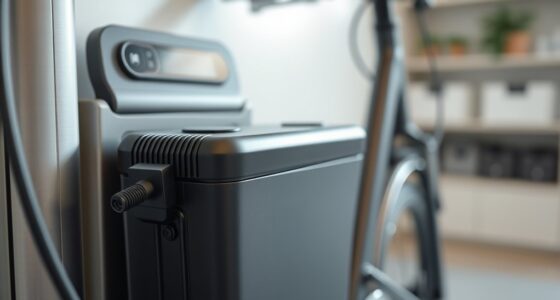To bleed hydraulic disc brakes on your e-bike, start by removing the wheel and caliper for easier access. Attach a bleed kit or syringe to the bleed port, and open the reservoir cap at the lever. Pump the brake to push out air and old fluid, then carefully open the bleed valve to release trapped air and fluid. Keep the reservoir topped up with fresh brake fluid. If you want a detailed step-by-step process, then keep exploring this guide.
Key Takeaways
- Remove the wheel and caliper for easier access, then attach a bleed kit or syringe to the bleed port securely.
- Open the brake reservoir cap and pump the lever to check for firmness; top up with the correct brake fluid as needed.
- Slowly open the bleed valve to release air and old fluid, keeping the reservoir topped up to prevent air ingress.
- Close the bleed valve securely, then test the brake lever for firmness; repeat if it feels spongy.
- Reinstall the wheel and caliper, then squeeze the brake lever multiple times to settle the fluid and pads.

Ever wondered how to restore your hydraulic disc brakes to peak performance? It’s a straightforward process once you understand the basics, and it can greatly improve your riding experience. The first step involves understanding brake fluid types. Your bike’s brake system may use mineral oil, DOT fluid, or sometimes even a specific type recommended by the manufacturer. Using the correct brake fluid is essential because incompatible fluids can cause damage to seals or reduce braking efficiency. Before starting, check your bike’s manual to confirm the right fluid type. If you need to replace the fluid, make sure you have the right tools and follow proper disposal methods for the old brake fluid. Flushing and replacing the fluid helps remove air bubbles, moisture, and contaminants, ensuring consistent braking. Additionally, selecting the right projector or screen for your setup can enhance your viewing experience, whether for casual movies or immersive gaming sessions.
Once you’ve confirmed the correct brake fluid, the next step is to prepare your bike for bleeding. Remove the wheel and brake caliper if necessary to access the brake housing easily. Before you begin, consider doing a pad replacement if the pads are worn out or contaminated. Fresh pads not only improve braking power but also help prevent issues like squealing or reduced responsiveness. When replacing the pads, ensure they’re properly aligned and seated, as misaligned pads can cause uneven wear or affect the bleeding process.
Now, you’re ready to bleed the brakes. Attach a syringe or a bleed kit to the brake caliper’s bleed port, making sure it’s tight to prevent leaks. Open the reservoir cap on the brake lever, and pump the brake lever several times to check for firmness. If it feels spongy or soft, it indicates air in the system, which needs to be purged. Slowly open the bleed valve, allowing old fluid and air bubbles to escape. Keep an eye on the fluid level in the reservoir, topping it off as needed to prevent air from being drawn back into the system. Use fresh brake fluid during the process to replace the old, contaminated fluid. After bleeding, close the bleed valve securely, then test the brake lever for firmness and responsiveness. If necessary, repeat the process until you get a solid, firm brake feel.
Finally, reassemble everything, reinstall the wheel and caliper, and give your brakes a few firm squeezes to settle the pads and fluid. Regularly maintaining your hydraulic disc brakes through routine bleeding and pad replacement guarantees you’ll have dependable stopping power whenever you need it, making your rides safer and more enjoyable.
Frequently Asked Questions
How Often Should I Bleed My E-Bike’s Hydraulic Disc Brakes?
You should bleed your e-bike’s hydraulic disc brakes whenever you notice decreased braking performance, spongy feel, or after brake pad maintenance and wheel alignment. Regularly check for air bubbles or fluid leaks, and bleed the brakes as needed—typically every 1-2 years or after replacing components. Keeping your brakes properly maintained ensures maximum stopping power and safety, so don’t delay bleeding if you notice any issues.
Can I Bleed Hydraulic Brakes Without Specialized Tools?
Yes, you can bleed hydraulic brakes without specialized tools, but it’s not always recommended for DIY maintenance. Using the correct brake fluid type is essential, so check your bike’s manual. You’ll need a clear syringe, tubing, and a container for brake fluid. Carefully follow the steps, ensuring you don’t introduce air into the system. If you’re unsure, it’s best to consult a professional to avoid damaging your brakes.
What Signs Indicate My Brakes Need Bleeding?
You’ll notice your brakes need bleeding if you experience a spongy or soft feel when you pull the brake lever, or if braking power diminishes despite brake pad replacement. Also, if your wheel alignment seems off or you hear squealing, it’s a sign air might be trapped in the system. Bleeding the brakes restores proper hydraulic pressure, ensuring safe stopping and preventing uneven wear on brake pads.
Is It Necessary to Replace Brake Fluid When Bleeding?
You might think you can just top off the brake fluid, but nope—it’s best to replace the brake fluid during bleeding. Old fluid loses its properties, like proper viscosity and lubrication, which impacts braking performance. During the bleeding procedure steps, fresh brake fluid ensures your system works flawlessly. So, don’t skip it; fresh fluid keeps your brakes responsive and safe, making replacement a simple yet essential part of the process.
Can I Upgrade to Higher-Performance Brake Fluid?
Yes, you can upgrade to higher-performance brake fluid, but make certain it’s compatible with your bike’s brake system. Check your manufacturer’s recommendations for brake fluid compatibility before switching. Performance fluid benefits include improved temperature stability, better resistance to fade, and enhanced braking feel. Upgrading can offer better overall braking performance, especially in demanding conditions, but always ensure compatibility to avoid system damage or reduced efficiency.
Conclusion
Now that you know how to bleed your hydraulic disc brakes, you can keep them responsive, reliable, and safe. Regular maintenance guarantees smooth braking, prevents future problems, and extends the life of your e-bike. By checking, bleeding, and maintaining your brakes, you’re taking control, ensuring safety, and enhancing performance. So, stay attentive, stay proactive, and enjoy confident rides—because well-maintained brakes mean better rides, better safety, and better adventures ahead.









